إن إيصال منتج أو خدمة إلى السوق يشبه تمامًا لعب لعبة مغامرات مليئة بالإثارة. أنت تتنقل في بيئة لا يمكن التنبؤ بها إلى حد كبير - والطريقة الوحيدة للفوز هي أن تكون مستعدًا للتغلب على العقبات التي تنتظرك في كل زاوية. 🤺
الآن، يجب على مدير المشروع أن يخطط لسيل لا نهاية له من الشكوك البيئية التي يمكن أن تؤثر على نتائج المشروع. من تجاوزات الميزانية وعدم كفاية الموارد البشرية إلى تقلبات السوق، هناك العديد من العناصر التي تؤثر بشكل كبير على كيفية تخطيط وتنفيذ مشروعك.
وهنا يأتي دور التحليل البيئي للمشروع، مما يساعدك على تحديد جميع العوامل والمخاطر المحتملة التي ينطوي عليها تنفيذ المشروع. وباتباع النهج الصحيح، لا يمكنك أن تكون مستعدًا للتعامل مع العوائق اليومية للمشروع فحسب، بل يمكنك أيضًا تقليل الضغط التشغيلي وتحسين تجربة كل صاحب مصلحة.
في هذه المقالة، سنستكشف بيئة المشروع ودورها في إدارة المشروع . سنغطي أيضًا:
- عوامل بيئة المشروع التي يمكن أن تؤثر على خطة المشروع
- تأثير بيئة المشروع عبر المراحل المختلفة لدورة حياة المشروع
- نصائح واستراتيجيات لتحليل بيئة المشروع وتحسينها
ما هي بيئة المشروع؟
نعلم جميعًا ما تعنيه البيئة بالمعنى العام - فهي تتكون من كل شيء، بما في ذلك الناس والطبيعة والسياسة، التي إما أن تدعمنا أو تهدد بقاءنا. وبالمثل، توجد المشاريع في بيئة تتألف من مكونات مثل أصحاب المصلحة في المشروع والمنافسين والتكنولوجيا، مما يشكل شبكة معقدة تحدد مدى نجاح المشروع.
بالتعريف، تشير بيئة المشروع إلى التأثير الجماعي لجميع العوامل التي يمكن أن تؤثر على نتائج نجاح المشروع:
- بشكل مباشر أو غير مباشر
- بطريقة سلبية أو إيجابية
- بشكل كمي أو غير ذلك
عندما يتعلق الأمر بإدارة المشاريع، تلعب دراسة بيئة المشروع دورًا حاسمًا في العديد من عمليات اتخاذ القرار، مثل
- مواءمة الأهداف الاستراتيجية للمشروع مع الأهداف التنظيمية
- وضع الميزانية وتخصيص الموارد
- تعديل خطط المشروع قصيرة الأجل وفقاً لظروف السوق
- تخطيط العمالة ولوجستيات التوريد بناءً على البيئة المحلية
عوامل بيئة المشروع الرئيسية: الداخلية والخارجية
من الضروري أن يكون لديك هيكلية أثناء تخطيط عوامل بيئة مشروعك. وبشكل عام، يمكنك تصنيفها بشكل عام إلى الفئتين التاليتين:
- العوامل الداخلية: تتألف عوامل بيئة المشروع الداخلية من عناصر داخلية في مؤسستك وتقع في الغالب ضمن سيطرتك المباشرة. وتشمل الأمثلة على ذلك موظفيك وديناميكيات الفريق وبرنامج إدارة المشروع التي يمكنك تشكيلها بسهولة من خلال السياسات أو القرارات الداخلية
- العوامل الخارجية: العوامل الخارجية التي ليست تحت سيطرتك ولكن يمكن أن تؤثر على نتائج المشروع. على سبيل المثال، حدوث تغيير في السلطة السياسية أو الامتثال التنظيمي في نطاق سلطتك القضائية
فيما يلي، سنقوم بتفصيل عوامل بيئة المشروع الداخلية والخارجية بالتفصيل. 👇
تحليل العوامل الداخلية
ضع في اعتبارك هذه العوامل الداخلية الأربعة التي تؤثر على جميع بيئات المشاريع، بغض النظر عن المجال الذي تعمل فيه:
1. أعضاء فريق المشروع
الموارد البشرية هم أصحاب المصلحة الداخليين الرئيسيين لديك ويؤثرون بشكل مباشر على جودة بيئة المشروع الداخلية.
وبصفتك مديرًا للمشروع، فإن مهمتك هي تتبع إنتاجية ومهارات ومستويات التزام وأداء كل عضو من أعضاء فريق المشروع، بالإضافة إلى الانتباه للعوامل المعطلة التي يمكن أن تبطئ من وتيرة العمل، مثل
- فريق المشروع المعرض للنزاعات
- عدم توفر الموظفين الرئيسيين خلال المشروع
مكافأة: استخدم قالب خطة إدارة فريق ClickUp لإدارة وتنظيم مواردك البشرية لأي مشروع. وهو مزود بقوائم مراجعة معدة مسبقاً لمراقبة صحة الفريق بشكل عام وتخطيط التحسينات القابلة للقياس والمصممة خصيصاً لبيئة مشروعك.
2. التكنولوجيا والبرمجيات
على حد سواء على نطاق صغير و مشاريع المؤسسات تتضمن العديد من الأنشطة المعقدة التي تتطلب استخدام التكنولوجيا. تؤثر البرامج والأدوات التي تستخدمها لتنفيذ هذه الأنشطة على بيئة مشروعك.
التصور العام هو أن تكنولوجيا مشروعك يمكن أن تزيد من إنتاجية الفريق أو تقللها بشكل كبير. من المهم أن تختار المنتج المناسب بعد إجراء تقييم شامل لحالة عملك ونطاق المشروع, متطلبات التسليم ومهارات الفريق 🦸
3. الأصول والموارد
جميع الأصول والموارد التي تستخدمها للمشروع تساهم أيضاً في بيئته. ويشمل ذلك الأصول قصيرة الأجل وطويلة الأجل، مثل البنية التحتية لمساحة العمل والمصنع والآلات والمواد الخام وما إلى ذلك. يجب عليك أن تأخذ فائدتها وتوافرها وقيودها في الاعتبار أثناء تخطيط المشروع .
4. الثقافة والهيكل التنظيمي
يؤثر هيكل وثقافة مؤسستك أيضًا على بيئة إدارة المشروع داخليًا. فعلى سبيل المثال، قد يؤدي الهيكل التنظيمي الذي يتجه من أعلى إلى أسفل مع استقلالية ضئيلة أو منعدمة إلى عدم مرونة في إدارة المشروع ثقافة عمل غير مرنة والتي يمكن أن تؤثر بشكل مباشر على جوانب مثل
- معنويات الفريق والإبداع
- كفاءة العملية والجداول الزمنية للمشروع
- معايير جودة المنتج أو الخدمة
نصيحة: تحليل الثقافة التنظيمية مهمة صعبة لأنها تتطلب النظر في الجوانب غير الملموسة مثل قيم الفريق المشتركة والمبادرات ذات الأولوية. لحسن الحظ، يمكنك الاستفادة من قالب ثقافة شركة ClickUp -تساعد ميزات تحديد الأهداف والتحرير التعاوني في تبسيط قيم شركتك وأولوياتها ومواءمة فريقك عبر الأقسام.
تحليل العوامل الخارجية
يمكن أن تختلف بيئة المشروع الخارجية بشكل كبير حسب المجال الذي تعمل فيه. وهنا، يتمثل دور مدير المشروع في دراسة البيئة الخارجية ووضع استراتيجيات لمعالجة المخاطر المحتملة أو تحقيق الفرص.
تتضمن بعض العوامل الشائعة التي يمكنك أخذها بعين الاعتبار ما يلي
1. ظروف السوق الاستهلاكية والبيئة التنافسية
أكثر أصحاب المصلحة الخارجيين تأثيراً في بيئة أي مشروع هم المستهلكون النهائيون. عليك أن تراقب التحولات في متطلباتهم التي يمكن أن تغير بشكل كبير أو حتى تلغي الطلب على منتجك.
وبالمثل، فإن تحركات منافسيك ستتلاعب ببيئة مشروعك. راقب التطورات التي يمكن أن تؤثر على ربحيتك، مثل:
- انخفاض حواجز الدخول وزيادة عدد المنافسين
- إطلاق منتج أعلى جودة
- تكتيكات التسويق والتسعير العدوانية
2. البيئة الاقتصادية
لا تشكل البيئة الاقتصادية جزءًا كبيرًا من مصطلحات إدارة المشاريع ولكن تأثيرها على بيئات المشاريع يمكن أن يكون عميقًا. فظروف الاقتصاد الكلي مثل التضخم والركود والتغيرات في السياسات المالية تؤثر على القوة الشرائية للعملاء وأنماط الطلب
بالإضافة إلى ذلك، يمكن أن يواجه المشروع أيضًا انتكاسات بسبب التغييرات في اقتصاد سلسلة التوريد أو التوزيع، مما يغير القوة التفاوضية للموردين والمشترين.
3. البيئة التنظيمية والسياسية
تشمل البيئة السياسية القواعد والسياسات واللوائح التنظيمية التي تفرضها الحكومة والتي يمكن أن تزيد من حدة سير العمل في الامتثال أو تعطل سلاسل التوريد والتوزيع أو تستلزم دفع أجور عمالة أعلى. يتجلى تأثير البيئة السياسية بشكل أكبر في شركات الرعاية الصحية والعقارات والشركات القائمة على التمويل.
4. البيئة التكنولوجية
على مدى العقود الثلاثة الماضية، برزت التكنولوجيا كقوة مزعزعة رئيسية لمعظم الصناعات. وغالبًا ما تجعل التقنيات الجديدة والمحسنة المنتجات الحالية قديمة أو تقدم طرقًا أكثر كفاءة لتحسين مهام المشروع.
نصيحة: جرّب نموذج تحليل الاحتياجات التكنولوجية ل ClickUp لتصور الاحتياجات التكنولوجية الحالية والمستقبلية لفريق مشروعك من خلال طرق عرض القائمة واللوحة الأنيقة.
5. البيئة المادية والثقافية والاجتماعية
تغطي البيئة الفيزيائية والاجتماعية والثقافية العوامل التي يمكن استخلاصها من البيئة المحلية وتأثيرها تنفيذ المشروع . على سبيل المثال، يمكن أن تنطوي البيئة المادية لمشروعك على ظروف مناخية رطبة تقلل من العمر الافتراضي للمواد الخام، في حين أن البيئة الاجتماعية للمنطقة تجعل من الصعب العثور على عمال مستعدين للعمل لساعات إضافية.
كيف يجب على مدير المشروع تحليل بيئة المشروع؟
إن دراسة بيئة المشروع هو أمر يجب على كل مدير مشروع القيام به، ولكن هناك بعض الحيرة حول من أين يبدأ. لقد أفردنا خمس طرق لتحليل بيئة المشروع أدناه - يمكنك استخدام مزيج من خيار واحد أو أكثر لتحليلك:
1. تحليل SWOT
يعتبر تحليل SWOT (ويسمى أيضاً التحليل الظرفي) هو الطريقة التي يمكنك من خلالها تحديد تأثير جميع العوامل الداخلية والخارجية في بيئة مشروعك. والفكرة هي تصنيف هذه العوامل إلى أربع فئات: _نقاط القوة، و نقاط القوة، و نقاط الضعف، و الفرص، و الفرص، و التهديدات
| فئة SWOT Category | نوع العامل | المعنى | ||
|---|---|---|---|---|
| نقاط القوة | داخلي | ميزتك التنافسية | ||
| نقاط الضعف | الداخلية | نقاط الضعف | الداخلية | المزالق الداخلية التي تحتاج إلى معالجة |
| الفرص | الخارجية | الظروف والاتجاهات الخارجية التي يمكنك استغلالها | ||
| التهديدات | الخارجية | المؤثرات الخارجية | المؤثرات الخارجية التي تعرض مشروعك للخطر |
ثم يتم تخطيط كل شيء بعد ذلك في قائمة أو مصفوفة للفهم البصري السريع.
قم بإجراء تحليل SWOT قابل للتنفيذ باستخدام قوالب ClickUp واللوحات البيضاء
إن أسهل طريقة لإجراء هذا التحليل هي استخدام نموذج قالب تحليل SWOT الشخصي ClickUp . يسمح لك بتبادل الأفكار مع فريقك وإدراج عوامل بيئة المشروع المختلفة إلى جانب تأثيرها. تصور العوامل في عرض جدول ClickUp أو اللوحات البيضاء واستخدام البيانات لإنشاء خطط قابلة للتنفيذ. 💡
2. تحليل PESTLE
إذا كنت تريد تحليلاً أكثر تفصيلاً لبيئة مشروعك الخارجية، فاختر تحليل PESTLE. فهو يركز حصرياً على ستة عوامل خارجية يمكن أن تؤثر على مشروعك:
- السياسية
- هاقتصادية
- اجتماعيثقافي
- تتكنولوجي
- لقانوني
- Eالبيئية
إجراء تحليل PESTLE قبل بدء المشروع مباشرةً لتكوين فكرة قوية عن النظام البيئي للصناعة. القفز على نموذج تحليل PESTLE الخاص بـ ClickUp PESTLE لتجربة أكثر سلاسة. يأتي مع:
- دليل مدمج لبدء الاستخدام
- الحقول المخصصة لتجميع العناصر الصغيرة والعوامل وتسجيل الوصف والتصنيف لكل منها
- طرق عرض القائمة واللوحة لتصور العوامل
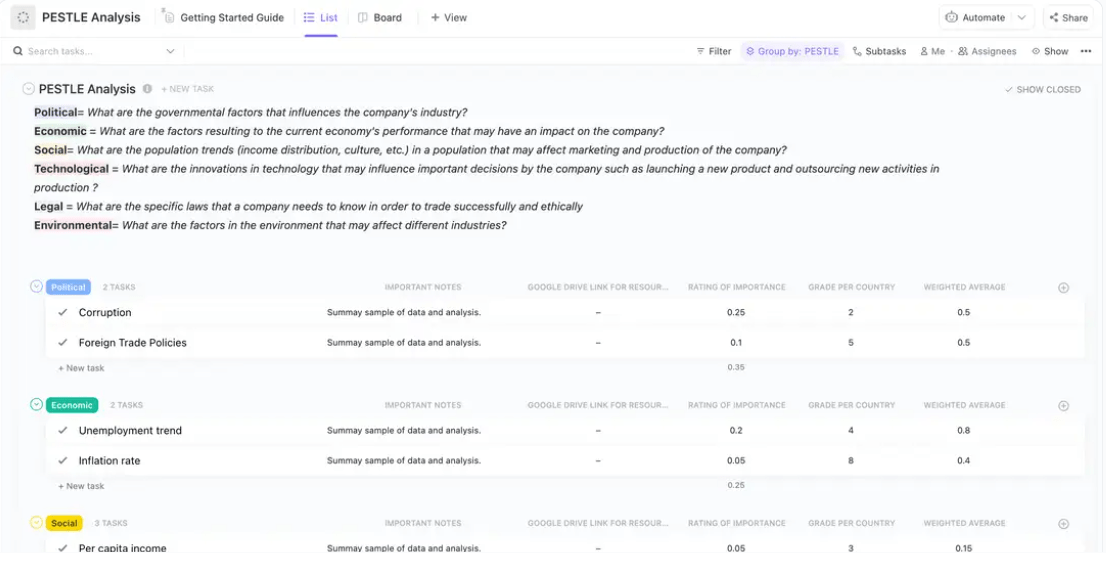
استكشف قالب ClickUp PESTLE Analysis كأداة قيّمة لتوقع الخسائر ومنع المخاطر وفهم قدرات الأعمال
3. تحليل القوى الخمس لبورتر تم تقديمه لأول مرة عام 1979 بواسطة
أستاذ كلية هارفارد للأعمال مايكل بورتر يبحث هذا الأسلوب الشائع في تأثير القوى التنافسية الخمس في أي سوق، وهي:
- التنافس بين المنافسين الحاليين
- التهديد من الداخلين الجدد
- قوة الموردين من حيث المساومة على الأسعار والصفقات
- قوة المشتري من حيث السعر والطلب وإمكانات الولاء
- توافر البدائل التي يمكن أن تؤثر على الربحية
إذا كنت بحاجة إلى مساعدة، يمكنك استخدام نموذج القوى الخمس لبورتر ClickUp Porter's 5 Forces لإجراء هذا التحليل. إنه قالب لوحة بيضاء، يتيح لك فهم العلاقة بين القوى التنافسية المختلفة على خريطة مرئية مرمزة بالألوان.
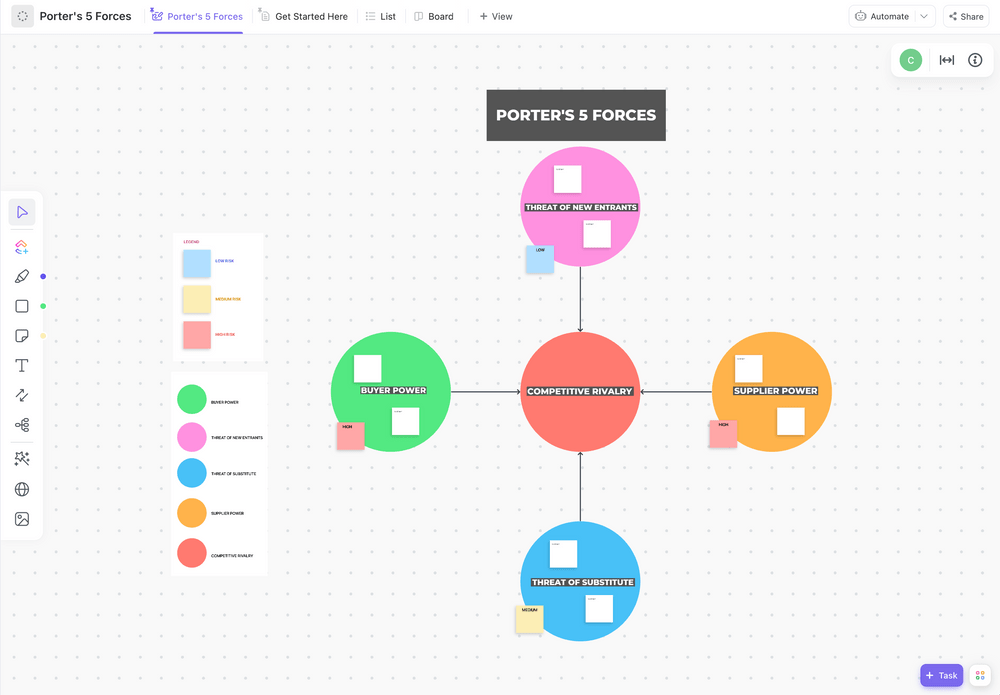
بالنسبة للشركات التي تسعى إلى تحسين فهم الصناعة وصياغة استراتيجيات مؤثرة، يثبت هذا القالب الديناميكي سهل الاستخدام والديناميكي أنه رصيد لا يقدر بثمن
4. تحليل أصحاب المصلحة
يشمل أصحاب المصلحة في المشروع موظفيك وعملائك ومديريك ومالكي المنتجات والموردين وما إلى ذلك - بشكل أساسي كل من له مصلحة في المشروع ويمكنه التأثير على بيئة المشروع بقراراته وإجراءاته. يتطلب منك تحليل أصحاب المصلحة تنظيم أصحاب المصلحة وفقًا للسلطة التي يمتلكونها على مشروعك.
لإجراء هذا التحليل، استخدم نموذج تحليل أصحاب المصلحة ClickUp Stakeholder Analysis . وهو يقدم نظرة عامة تقنية للغاية ومرمزة بالألوان لأصحاب المصلحة الرئيسيين الخارجيين والداخليين وتأثيرهم عبر مراحل المشروع. يمكنك تسجيل الإجراءات التي تحتاج إلى اتخاذها لدعم كل صاحب مصلحة في المشروع في القالب نفسه.
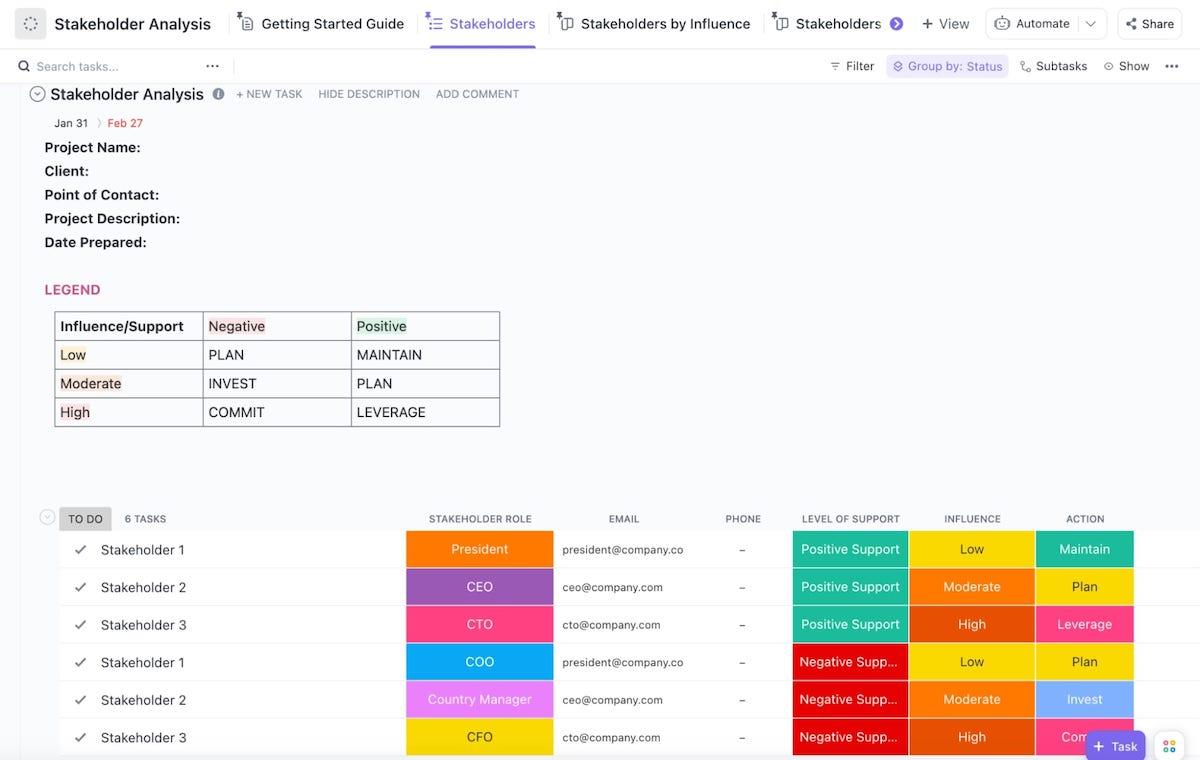
يسمح لك قالب تحليل أصحاب المصلحة من ClickUp بتسجيل دور أصحاب المصلحة في مشروعك وتأثيرهم وتأثيرهم وإجراءاتهم
5. تحليل المنافسين
يسمح لك تحليل المنافسين بالتركيز بالليزر على منافسيك وتأثيرهم المحتمل على التسعير واستراتيجيات التسويق وتطوير المنتجات. واعتمادًا على مجال عملك أو سوقك المتخصص، يمكنك الغوص في منافس معين وتحليل هيكله التنظيمي والتأثيرات البيئية وفهم قراراته.
لدى ClickUp مجموعة من قوالب تحليل المنافسين لحالات الأعمال المختلفة. على سبيل المثال، فإن نموذج تسعير التحليل التنافسي لـ ClickUp للتحليل التنافسي يتيح لك مراقبة خصومات المنافسين وعروضهم التي تساعدك على الاستجابة في الوقت المناسب مع تعديل الأسعار.

قم بتوثيق الأسعار وتفصيلها بسهولة عبر مجال عملك للحصول على بيانات تنافسية قابلة للتشريح
كيف تؤثر عوامل بيئة المشروع على دورة حياة إدارة المشروع
من سوء الفهم الشائع لدى مديري المشاريع أن تحليل بيئة المشروع هو أمر نقوم به في بداية المشروع. في الواقع، تؤثر عوامل بيئة المشروع على جميع المراحل الخمس في دورة حياة إدارة المشروع . دعونا نستكشف كيف:
المرحلة 1: البدء
بيئة المشروع محدودة في هذه المرحلة. وتتكون من أعضاء فريق المشروع والسوق المستهدف. والهدف هو إجراء دراسة جدوى للعمل على التطوير المفاهيمي وجدوى المشروع.
المرحلة 2: التخطيط
في هذه المرحلة، تشمل بيئة المشروع القيادة وفرق المشروع المشاركة في مهام التخطيط والجدولة ووضع الميزانية والاستثمار التقني وتخصيص الموارد. يجب مراعاة العوامل التشغيلية مثل الموردين وتوافر العمالة, تحديد المخاطر وإنشاء استراتيجية التخفيف . 🛡️
المرحلة 3: التنفيذ
الآن، أصبحت بيئة المشروع معقدة للغاية لأنها تضم العديد من أصحاب المصلحة والأصول والموارد والتكنولوجيا التي تستخدمها للمشروع. لقد أصبح لديك فرق العمل المتنامية تظل أحد العوامل البيئية الرئيسية، ويجب عليك وضع تدفقات عمل يومية مفصلة وخطط تواصل لضمان سلاسة التنفيذ.
المرحلة 4: المراقبة
تسير هذه المرحلة بالتوازي مع مرحلة التنفيذ. وهنا، يراقب مدير المشروع بنشاط عوامل بيئة المشروع التي تم تحديدها كمخاطر خلال مرحلة التخطيط، ويبذل جهدًا لترويض المؤثرات المارقة، ويضبط خطة المشروع إذا لزم الأمر
المرحلة 5: الإغلاق
بمجرد اكتمال المشروع وتسليمه إلى العميل أو السوق، يصبح المستهلكون النهائيون هم المهيمنون على بيئة المشروع. ويتمثل عملك في تحليل أداء المشروع وإجراء عمليات مراجعة وتدوين الدروس المستفادة للمشاريع المستقبلية. ✍️
عوامل بيئة المشروع عبر دورة حياة المشروع: مثال على ذلك
لنفترض أن تطوير البرمجيات شركة لديها مشروع جديد لبناء برنامج إدارة المرضى لسلسلة مستشفيات متنامية. فيما يلي كيفية تطور بيئة المشروع في كل مرحلة:
- البدء: تشمل البيئة الداخلية في هذه المرحلة فريق التطوير الأساسي وممثلي العميل. يتم تحديد البيئة الخارجية مع احتياجات المرضى وموظفي المستشفى، والاتجاهات الناشئة في إدارة المستشفى، والمتطلبات التنظيمية - هذه العوامل تحتاج أيضًا إلى المناورة في بقية المراحل
- تخطيط المشروع: يتم الآن إدخال وثائق التخطيط والموارد، مثل مكتبات تطوير البرمجيات والعقود والميزانيات والاستشاريين
- التنفيذ والمراقبة: تتوسع بيئة المشروع الآن لتشمل المزيد منمحررو التعليمات البرمجية وبرنامج خادم محسن، بينما يراقب نظام إدارة المشروع الداخلي التقدم والمخاطر
- الخاتمة: البرنامج جاهز الآن، ويقوم المطورون بإجراء عرض تجريبي للعملاء. سيستخدم موظفو المستشفى المنتج ويشاركون تجربتهم مع العملاء، ربما مقارنة بالمنتجات المنافسة ✌️
تحديات بيئة المشروع وكيف يساعد برنامج ClickUp في إدارتها
هناك ثلاثة تحديات رئيسية تواجهك عند إدارة أي بيئة مشروع:
- التعقيد البيئي: حتى أفضل مديري المشاريع يجدون صعوبة في التعامل مع عوامل بيئة المشروع المتنوعة. هناك دائماً احتمال أن يفوتك شيء ما
- العوامل البيئية المتطورة باستمرار: تتطور عوامل بيئة المشروع باستمرار، وكذلك تأثيراتها. ومع ذلك، فإن مراقبة كل شيء بانتظام هي مهمة شاقة ومعرضة لمشاكل مثل الحمل الزائد للمعلومات
- مشاكل تنظيم البيانات: الرصد المنتظم لعوامل بيئة المشروع يولد مجموعة كبيرة من البيانات التي غالباً ما تكون مبعثرة وصعبة المعالجة
لاحظ أن هذه المشاكل شائعة التحديات في أي إدارة مشروع ويمكنك التغلب عليها بسهولة باستخدام برامج إدارة المشاريع الشاملة مثل ClickUp ! 🌹
في الأقسام التالية، سنعرفك في الأقسام التالية على بعض الميزات المفيدة في مجموعة ClickUp لإدارة المشاريع -مصممة لتبسيط بيئات المشاريع ومراقبتها بسهولة.
1. إدارة بيئات المشاريع المعقدة باستخدام أدوات التصور الخاصة بـ ClickUp
أفضل طريقة لإدارة بيئة مشروع معقدة هي من خلال التصور المناسب لعواملها وكيفية ارتباطها بعملياتك. لحسن الحظ، يساعدك ClickUp على فهم كل شيء من خلال أدوات التصور.
بالنسبة للمبتدئين، يمكنك استخدام انقر فوق التبعيات لتتبع العلاقات بين مكونات المشروع الخارجية والداخلية والمهام المترابطة - على سبيل المثال، ربط وقت التسليم الخاص بالمورّد بالجدول الزمني للإنتاج. العملية بسيطة. كل ما عليك فعله هو إنشاء مهمة في ClickUp وتمكين أي من الخيارات التالية:
- إذا كان على المهمة أن تنتظر اكتمال مهام أخرى، أضف تبعية انتظار
- أضف تبعية حظر للمهام التي تحتاج إلى إكمالها قبل المهام الأخرى
وعلاوة على ذلك، يمكنك تصور سير عمل المشروع والتبعيات عبر دورة حياة المشروع على انقر فوق عرض مخطط جانت البياني . يتيح لك إعداد خط أساس للمشروع مع جدول زمني مرن للتسليم. يمكنك استكشاف الفروق بسبب العوامل المتداخلة وتعديل جدولك الزمني وفقًا لذلك.
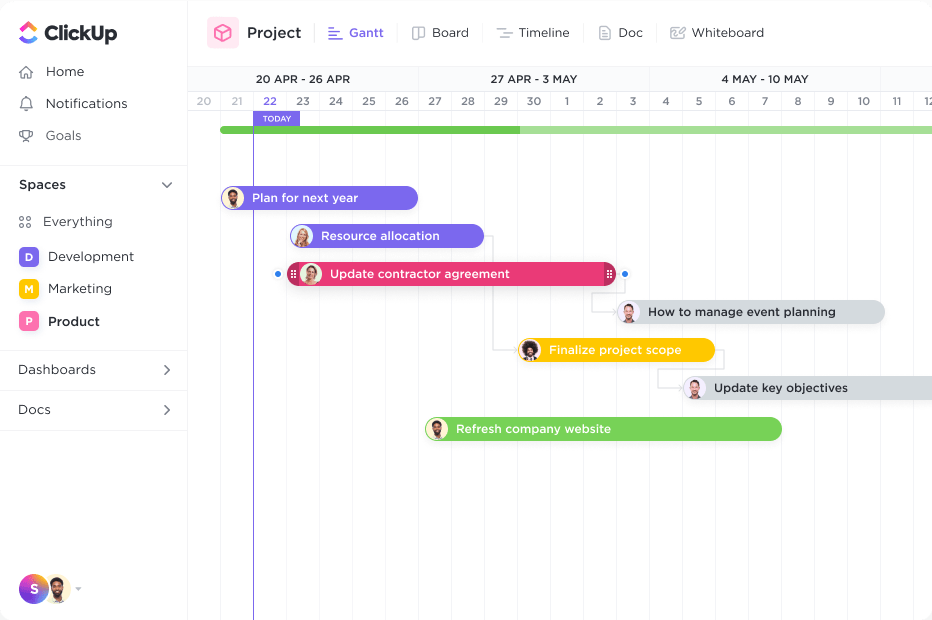
تخطيط المشاريع وإدارة التبعيات وتحديد أولويات المهام باستخدام عرض جانت في ClickUp
بالنسبة للعوامل ذات العلاقات الأكثر تعقيدًا، يمكنك تصورها على ClickUp Whiteboards ودعوة فريقك لتبادل الأفكار حول الحلول. توفر ميزة السبورة البيضاء الرقمية هذه لوحة لا متناهية مع أدوات الرسم والموصلات والملاحظات اللاصقة لتخطيط تدفقات المهام المعقدة وتخطيط الاستراتيجيات البديلة حسب الضرورة.
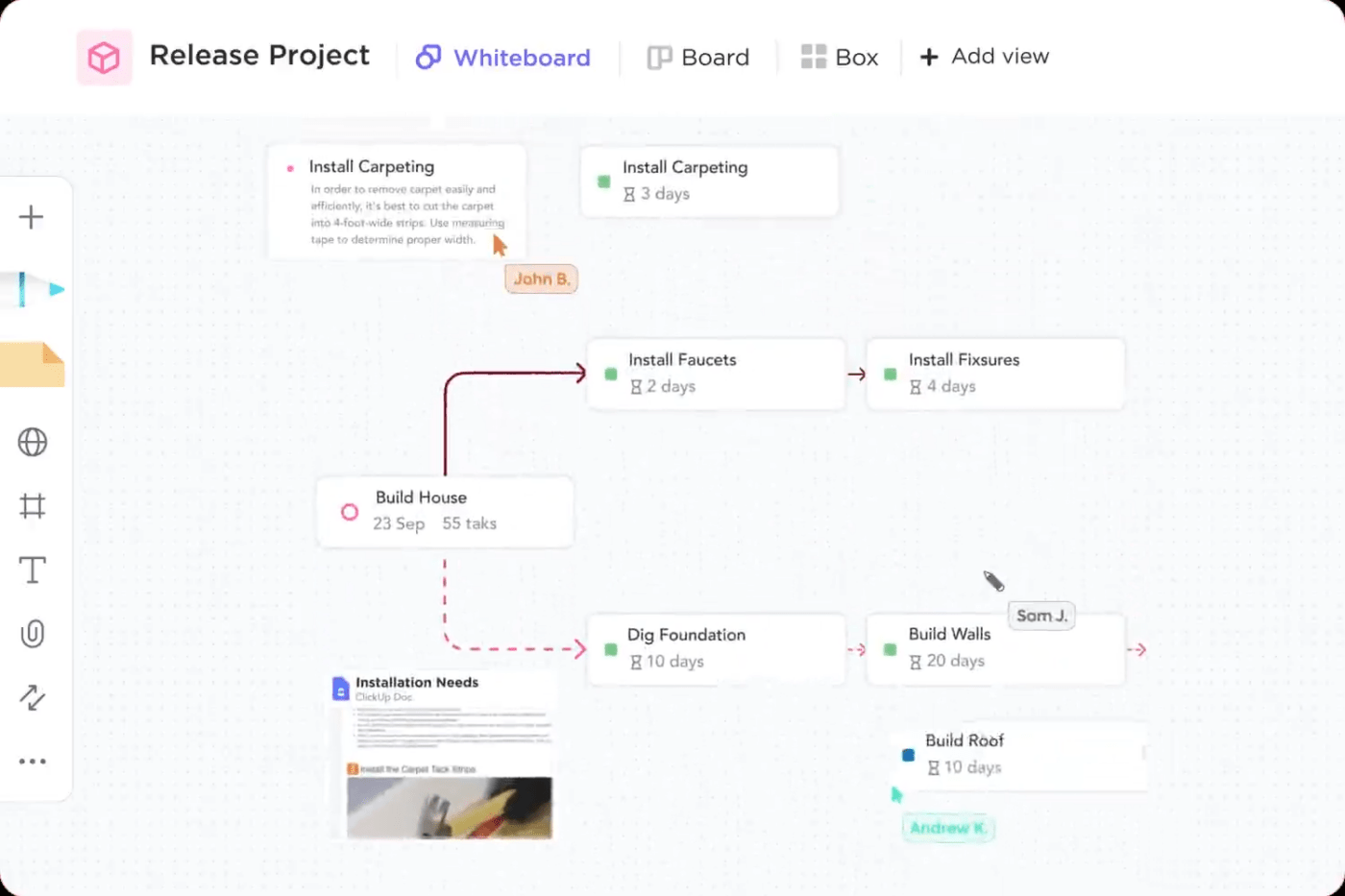
استخدم القوة الإبداعية للوحات المعلومات الخاصة ب ClickUp لتحويل الأفكار إلى أفعال
2. تتبع عوامل المشروع الديناميكية باستخدام أهداف ClickUp ولوحات المعلومات
إذا كانت عوامل بيئة مشروعك تبدو وكأنها أهداف متحركة، فإن الحل الوحيد للبقاء على القمة هو مراقبتها بدقة.
يمكنك الآن تتبع عوامل بيئة مشروعك في الوقت الفعلي باستخدام أهداف ClickUp . حدد أهدافًا قابلة للقياس لمقاييس الأداء المثالية للموظفين والمشروعات - كل ما عليك فعله الآن هو مراقبة التغييرات لمعرفة ما إذا كان أي عنصر من عناصر بيئة المشروع يتصرف بشكل سيء. يمكنك أيضًا تعيين مقاييس لعوامل إدارة المشاريع القياسية، مثل ساعات عمل الموظفين المتوقعة وطول عمر المعدات، ومراقبة التقلبات.
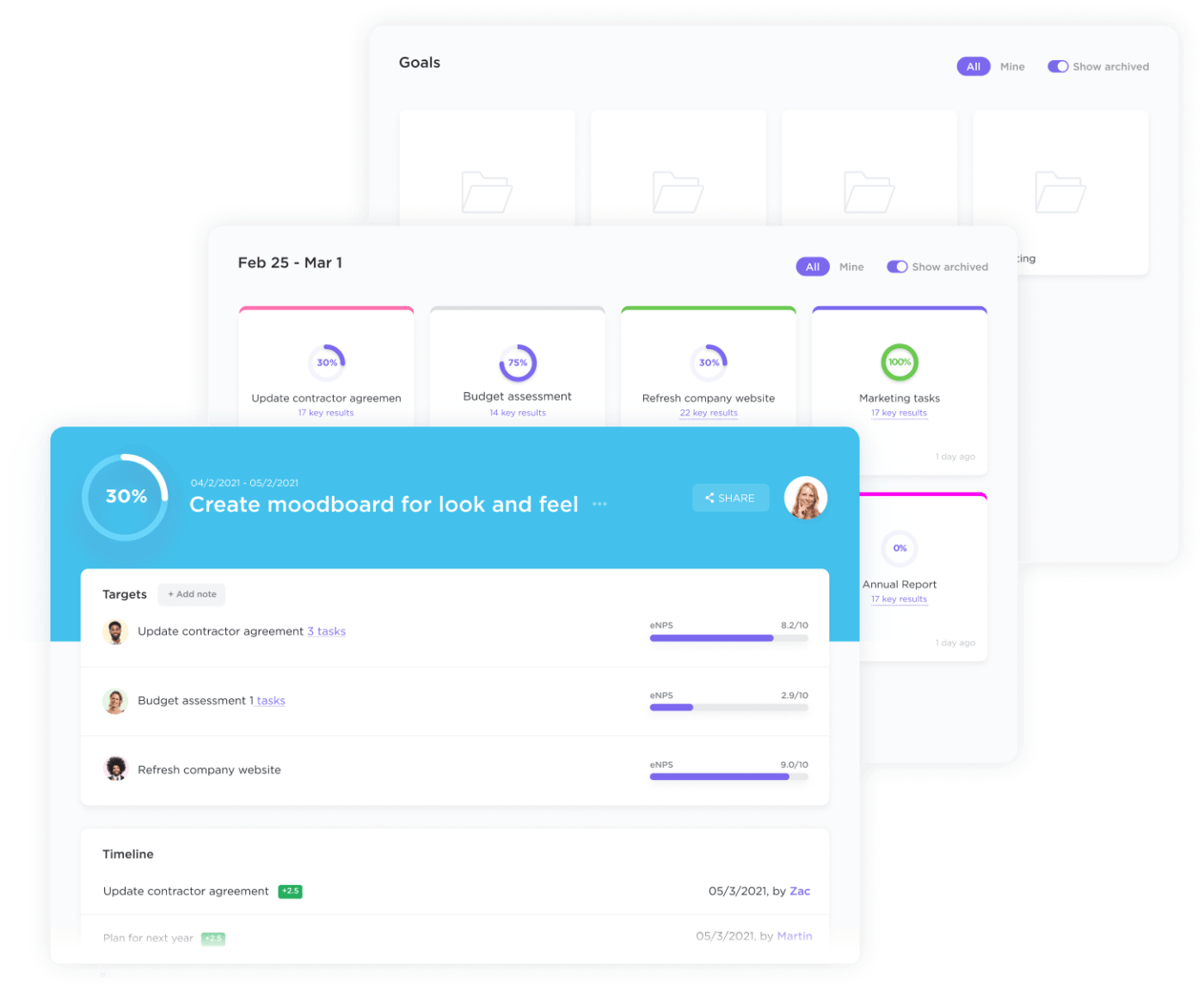
تتبع التقدم المحرز في كل هدف باستخدام طرق عرض مختلفة على ClickUp
على سبيل المثال، إذا فشل المشروع في تحقيق هدف المبيعات الأولي، يمكنك أن تكون استباقيًا في إجراء تحليل متعمق للسوق أو المنافسين. سيسمح لك ذلك بتحديد العوامل البيئية التي أدت إلى الانحراف.
إذا كنت قلقًا بشأن الحمل الزائد للمعلومات الناتجة عن تتبع أهداف متعددة، فنحن معك! ما عليك سوى تتبع جميع مقاييسك في مكان واحد باستخدام لوحات معلومات ClickUp . أنشئ لوحة معلومات مخصصة عن طريق إضافة بطاقات، ورسوم بيانية، ومخططات خطية، ومخططات دائرية تتعقب البيانات التي اخترتها في الوقت الفعلي.
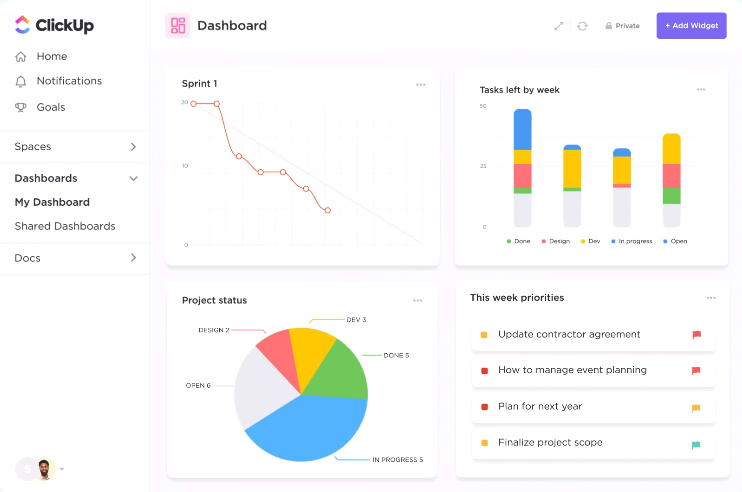
احصل على نظرة عامة عالية المستوى على عملك من خلال لوحات معلومات ClickUp Dashboards القابلة للتخصيص
3. استخدم مستندات ClickUp Docs لتنظيم البيانات والمعلومات في مساحات المشروع
بالنظر إلى النطاق الواسع للعناصر الموجودة في المشروع، يجب أن يكون لديك ترتيب لتسجيل بيانات المشروع وتخزينها بطريقة منظمة.
لحسن الحظ، يمكن لـ ClickUp تقديم المساعدة هنا أيضاً، وذلك بفضل ميزات إدارة البيانات مثل:
- مستندات ClickUp لتسجيل المعلومات حول عوامل بيئة المشروع مثل اللوائح والاتجاهات الناشئة وأصحاب المصلحة في المشروع واستراتيجيات المنافسين
- مهام ClickUp لتنظيم سير العمل الخاص بك - يمكن البحث فيها بسهولة عن طريق المعينين وعلامات المهام
- انقر فوق الدردشة لتنظيم التواصل مع الموظفين والإدارة العليا وتبسيطه
إنشاء مساحات عمل مخصصة للمشروع لتخزين جميع بيانات المشروع في مكان واحد لسهولة استرجاعها ومعالجتها. علاوة على ذلك، يمكنك تحليل هذه البيانات بشكل أكبر باستخدام:
- ClickUp Brain : مساعد الذكاء الاصطناعي الخاص بالمنصة الذي يعمل كشبكة عصبية تربط بين المستندات والمهام و الأشخاص الخاصة بالمشروع
- طرق عرض ClickUp : تتيح هذه الميزة إضافة وجهات نظر مختلفة لنفس البيانات. التبديل بين أكثر من 15 طريقة عرض، بما في ذلك طرق عرض القائمة والجدول والجدول الزمني والتقويم
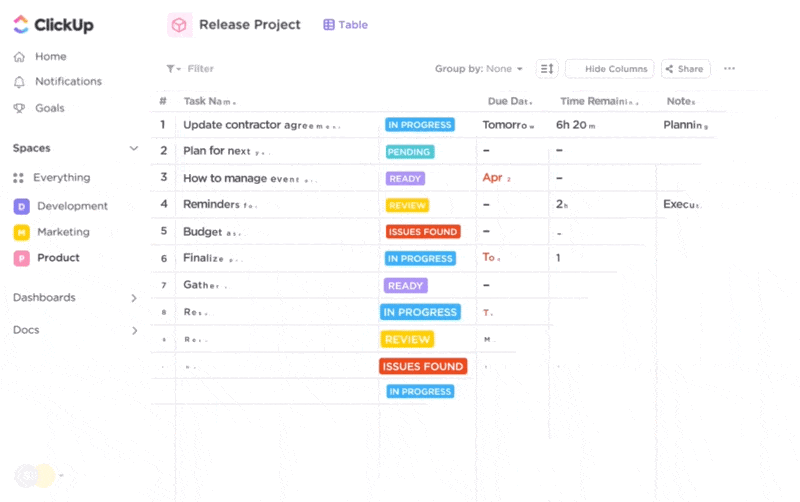
استكشف ClickUp لإدارة مشاريعك بقوة الذكاء الاصطناعي وأكثر من 15 طريقة عرض وأتمتة المهام
مكافأة: استفد من قوالب إدارة المشاريع ClickUp
تقدم ClickUp أكثر من 1,000 مهمة و قوالب إدارة المشاريع في جميع حالات الاستخدام. زيارة معرض القوالب لاستكشاف القوالب الفريدة لتتبع عوامل بيئة مشروع معينة.
إذا كنت مدير مشروع، فإننا نوصي باستخدام قالب إدارة مشروع ClickUp لإعداد لوحة تحكم قوية لمشروعك، حتى في أكثر البيئات صعوبة.
صُمم هذا القالب لمساعدتك في قيادة مشروعك من البداية وحتى الانتهاء. استخدمه المدمج فيه:
- عرض المستندات للعثور على مستندات مشروعك
- عرض جانت لتصور التبعيات
- عرض قائمة المهام مرتبة حسب الحالة أو معلمات أخرى
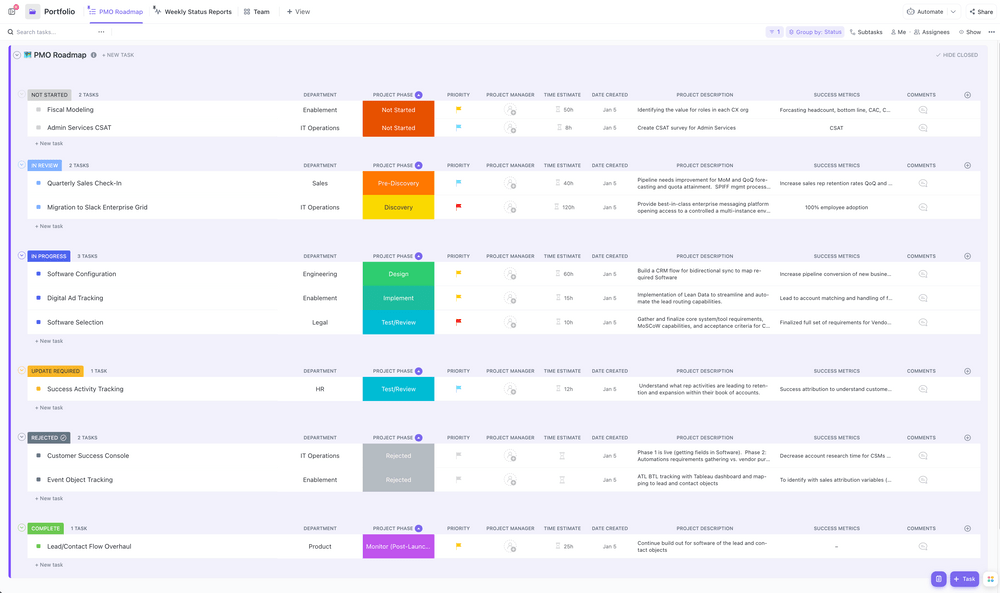
يسمح لك قالب محفظة إدارة المشاريع بتتبع المشاريع بسهولة في جميع الأقسام والبرامج مع مراقبة سلامتها وتقدمها.
تمتع بإدارة ناجحة للمشروعات وتحليل بيئة المشروع مع ClickUp
A أداة إدارة المشروع مثل ClickUp يمكن أن تساعد مشروعك على الازدهار في أي إعداد. فمع ميزات مراقبة عوامل بيئة المشروع وتخطيط سير العمل واستراتيجيات المخاطر، لن تضطر إلى السباحة عكس التيار للحصول على النتائج المرجوة!
إذن, اشترك في ClickUp مجانًا وابدأ في إدارة بيئة مشروعك بشكل استباقي. 💗


